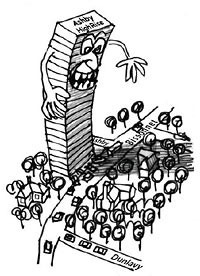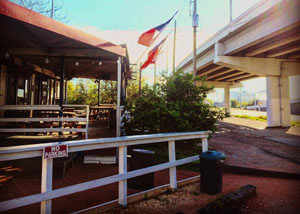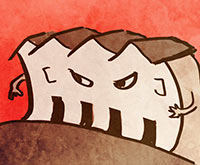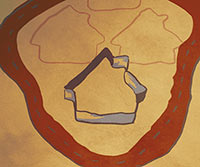COMMENT OF THE DAY: ALL FLOODING BUCKS PASS THE SAME DIRECTION  “Every solid thing built in a floodplain displaces water to the surrounding areas and to downstream. Houston just keeps screwing its southeast neighbors.” [movocelot, commenting on Elan Heights Shows Off Its 4 Floors of Apartment Flooding Insurance]
“Every solid thing built in a floodplain displaces water to the surrounding areas and to downstream. Houston just keeps screwing its southeast neighbors.” [movocelot, commenting on Elan Heights Shows Off Its 4 Floors of Apartment Flooding Insurance]
Tag: Development Patterns
COMMENT OF THE DAY: THE JOBS WILL GO WHEREVER THE WIND BLOWS THEM  “I think it has less to do with the location of high-paying jobs, and more [to do with] proximity to the Ship Channel and its pollution. If you look at wind pattern maps, all the historically least-desirable areas are where prevailing winds off the coast end up tending to blow pollution originating from the Ship Channel. The high-income jobs are located west of downtown because that’s where the high-income people wanted to live, not the other way around. This isn’t specific to Houston, either – the west side of most North American cities tends to be the more desirable side, owing to prevailing winds and the location of dirty industrial areas. Chicago is an excellent example — the south side being less desirable owing to its location downwind (south and east) of the massive stockyards that existed there a century ago.” [TMR, commenting on Comment of the Day: Breaking the Cyclical Expansion of the Donut of Despair] Illustration: Lulu
“I think it has less to do with the location of high-paying jobs, and more [to do with] proximity to the Ship Channel and its pollution. If you look at wind pattern maps, all the historically least-desirable areas are where prevailing winds off the coast end up tending to blow pollution originating from the Ship Channel. The high-income jobs are located west of downtown because that’s where the high-income people wanted to live, not the other way around. This isn’t specific to Houston, either – the west side of most North American cities tends to be the more desirable side, owing to prevailing winds and the location of dirty industrial areas. Chicago is an excellent example — the south side being less desirable owing to its location downwind (south and east) of the massive stockyards that existed there a century ago.” [TMR, commenting on Comment of the Day: Breaking the Cyclical Expansion of the Donut of Despair] Illustration: Lulu
COMMENT OF THE DAY: BREAKING THE CYCLICAL EXPANSION OF THE DONUT OF DESPAIR  “Nobody is suggesting that we go back to the old, post-war, car-centric way of developing. Even single family, suburban communities are now being built with something resembling walkability in mind. They have made the houses much more dense, and they have made efforts to link retail to the neighborhoods. But what we risk doing is creating donut cities: with a core of walkability, older suburbs that are not walkable, and a ring of new, sort-of-walkable suburbs. Worse than that, if we continue to starve those older suburbs of investment (on the idea that we don’t want to ‘throw good money after bad’ or whatever), we will create wealthy cores, poor old suburbs, and middle-class new suburbs. Still worse, if we allow this to happen, we will cause more sprawl, because middle class people won’t see the old suburbs as an option, so they’ll keep driving further and further out. At some point, like it or not, we will need to reinvest in those older suburbs – and it’s for the sake of building more sustainable, equitable cities.” [ZAW, commenting on Bellaire’s Hong Kong Chef Serves Last Customers; Sunbelt Cities Are Just Misunderstood; previously on Swamplot] Illustration: Lulu
“Nobody is suggesting that we go back to the old, post-war, car-centric way of developing. Even single family, suburban communities are now being built with something resembling walkability in mind. They have made the houses much more dense, and they have made efforts to link retail to the neighborhoods. But what we risk doing is creating donut cities: with a core of walkability, older suburbs that are not walkable, and a ring of new, sort-of-walkable suburbs. Worse than that, if we continue to starve those older suburbs of investment (on the idea that we don’t want to ‘throw good money after bad’ or whatever), we will create wealthy cores, poor old suburbs, and middle-class new suburbs. Still worse, if we allow this to happen, we will cause more sprawl, because middle class people won’t see the old suburbs as an option, so they’ll keep driving further and further out. At some point, like it or not, we will need to reinvest in those older suburbs – and it’s for the sake of building more sustainable, equitable cities.” [ZAW, commenting on Bellaire’s Hong Kong Chef Serves Last Customers; Sunbelt Cities Are Just Misunderstood; previously on Swamplot] Illustration: Lulu
COMMENT OF THE DAY: WHY DENSITY DOESN’T WORK IF YOU’RE THE ONLY ONE DOING IT  “I used to think the whole ‘Tower of Traffic’ slogan was BS — that greater density will increase walkability and reduce the need for cars. However, the way many highrises are sited in Houston completely eliminates the benefits of a highrise. They basically become vertical culs-de-sac, still car-dependent, because each one is located in pockets of lowest land value either next to freeways or in the middle of single-family-home neighborhoods. If I recall correctly, city council or the planning department passed a rule that forces developers to stick to building heights that are close to those of neighboring structures. Is this really the case? I think it’s a great way to better cluster high-density developments and walkable areas.” [Derek, commenting on A Bird’s-Eye View of the ExxonMobil Campus; The Ashby Highrise Effect] Illustration: Stop Ashby Highrise
“I used to think the whole ‘Tower of Traffic’ slogan was BS — that greater density will increase walkability and reduce the need for cars. However, the way many highrises are sited in Houston completely eliminates the benefits of a highrise. They basically become vertical culs-de-sac, still car-dependent, because each one is located in pockets of lowest land value either next to freeways or in the middle of single-family-home neighborhoods. If I recall correctly, city council or the planning department passed a rule that forces developers to stick to building heights that are close to those of neighboring structures. Is this really the case? I think it’s a great way to better cluster high-density developments and walkable areas.” [Derek, commenting on A Bird’s-Eye View of the ExxonMobil Campus; The Ashby Highrise Effect] Illustration: Stop Ashby Highrise
MEDITATIONS ON HOUSTON’S ICEHOUSES FROM THE GUY WHO STARTED PHOTOGRAPHING THEM LAST YEAR  What patterns have emerged to recent architecture grad David Richmond, roughly 7 months and 40 Shiners in on a year-long project to document Houston’s icehouses? Garage doors, and an embrace of Houston’s outside environment: Richmond writes that the icehouses’ “permanent openness inverts the last 50 years of Houston living — hot days are hot, ugly streets are visible, bad smells can linger, and humidity can ruin your day. The garage door becomes a way of existing in your location for what it is that day at that moment. The city is no longer an image through a window but a physical space.” Richmond plans to turn the project into a book; you can follow along on Twitter here. [Houston Chronicle, OffCite] Photo of Bubba’s Texas Burger Shack, between the Westpark Tollway overpass and US 59: Bubba’s Texas Burger Shack
What patterns have emerged to recent architecture grad David Richmond, roughly 7 months and 40 Shiners in on a year-long project to document Houston’s icehouses? Garage doors, and an embrace of Houston’s outside environment: Richmond writes that the icehouses’ “permanent openness inverts the last 50 years of Houston living — hot days are hot, ugly streets are visible, bad smells can linger, and humidity can ruin your day. The garage door becomes a way of existing in your location for what it is that day at that moment. The city is no longer an image through a window but a physical space.” Richmond plans to turn the project into a book; you can follow along on Twitter here. [Houston Chronicle, OffCite] Photo of Bubba’s Texas Burger Shack, between the Westpark Tollway overpass and US 59: Bubba’s Texas Burger Shack
COMMENT OF THE DAY: 2 ONE-WAY TRAJECTORIES FOR HOUSTON TOWNHOME DEVELOPMENT  ” . . . The big concern that I have about townhomes is that perhaps about 15 to 30 years out, and as they start to show their age in the predictable ways (never mind the less predictable ways that relate to the regional economy or transportation), that some individual owners in fee simple arrangements will shirk repairs and bring down entire clusters or neighborhoods. They are different from condo regimes in that way, but also in another: fractured land ownership and deed restrictions make redevelopment and land use change basically impossible. Forever. It’s possible that state laws and municipal ordinances would change to cope with things, or that Houston will become so affluent as to render the concern moot, but I see it as a risk.” [TheNiche, commenting on Raising the Bar for Upscale Housing; A New Hospital for Galveston] Illustration: Lulu
” . . . The big concern that I have about townhomes is that perhaps about 15 to 30 years out, and as they start to show their age in the predictable ways (never mind the less predictable ways that relate to the regional economy or transportation), that some individual owners in fee simple arrangements will shirk repairs and bring down entire clusters or neighborhoods. They are different from condo regimes in that way, but also in another: fractured land ownership and deed restrictions make redevelopment and land use change basically impossible. Forever. It’s possible that state laws and municipal ordinances would change to cope with things, or that Houston will become so affluent as to render the concern moot, but I see it as a risk.” [TheNiche, commenting on Raising the Bar for Upscale Housing; A New Hospital for Galveston] Illustration: Lulu
RUNNER-UP COMMENT OF THE DAY: READY FOR ICING OUTSIDE THE INNER LOOP  ” . . . I think the real opportunity to expand affordable housing is in Houston’s ‘donut of despair’. The area between 610 and the Beltway (except around the Spring Branch area) is full of acres and acres of empty land. With a huge push from the City, these areas could be redeveloped into truly affordable neighborhoods with homes in the $150-250k range.” [Old School, commenting on Houston Home Sales Continue To Tumble; One More Link in the Grand Parkway] Illustration: Lulu
” . . . I think the real opportunity to expand affordable housing is in Houston’s ‘donut of despair’. The area between 610 and the Beltway (except around the Spring Branch area) is full of acres and acres of empty land. With a huge push from the City, these areas could be redeveloped into truly affordable neighborhoods with homes in the $150-250k range.” [Old School, commenting on Houston Home Sales Continue To Tumble; One More Link in the Grand Parkway] Illustration: Lulu
COMMENT OF THE DAY: THERE’S A NAME FOR IT  “Someone needs to name the cycle of excitement and disappointment of watching new construction in Houston. The cycle begins with confusion over demo of a current structure, then rising excitement in anticipation of something new and novel, a small dip when you see what is being built looks like a generic suburban building, and the ultimate disappointment and resignation when you find out it is . . . an Olive Garden.” [Lindsey, commenting on New Olive Garden Now in Bloom on the South Side of 59, Near Buffalo Speedway] Illustration: Lulu
“Someone needs to name the cycle of excitement and disappointment of watching new construction in Houston. The cycle begins with confusion over demo of a current structure, then rising excitement in anticipation of something new and novel, a small dip when you see what is being built looks like a generic suburban building, and the ultimate disappointment and resignation when you find out it is . . . an Olive Garden.” [Lindsey, commenting on New Olive Garden Now in Bloom on the South Side of 59, Near Buffalo Speedway] Illustration: Lulu
COMMENT OF THE DAY: HOW IT WORKS IN HOUSTON, THE FREE ENTERPRISE CITY  “. . . That is, and always has been, Houston. That unruly sprawl, those cookie-cutter suburbs, generic strip malls, traffic congestion, that all existed long before the Beltway was built. I grew up here, in a cookie-cutter suburb called ‘Sagemont’ located next to a 2 lane stretch of blacktop named ‘South Belt.’ My dad grew up in a cookie-cutter suburb 10 miles closer in, filled with generic strip malls, just outside what would become the 610 Loop. Today I live in another cookie-cutter suburb farther west, about half way between 610 and the Beltway. Still lots of congestion, sprawl, strip centers, etc. This is Houston, baby.
And just about everything in Houston exists because some powerful person (not necessarily a politician) owned tracts of land. All of those hip dense neighborhoods? They were empty fields that some speculator bought for next to nothing, then bribed . . . er, influenced someone in government to build something, often with tax dollars. That’s how things get done.” [Memebag, commenting on Driving Beltway 8, in Order To Read Houston in the Original] Illustration: Lulu
“. . . That is, and always has been, Houston. That unruly sprawl, those cookie-cutter suburbs, generic strip malls, traffic congestion, that all existed long before the Beltway was built. I grew up here, in a cookie-cutter suburb called ‘Sagemont’ located next to a 2 lane stretch of blacktop named ‘South Belt.’ My dad grew up in a cookie-cutter suburb 10 miles closer in, filled with generic strip malls, just outside what would become the 610 Loop. Today I live in another cookie-cutter suburb farther west, about half way between 610 and the Beltway. Still lots of congestion, sprawl, strip centers, etc. This is Houston, baby.
And just about everything in Houston exists because some powerful person (not necessarily a politician) owned tracts of land. All of those hip dense neighborhoods? They were empty fields that some speculator bought for next to nothing, then bribed . . . er, influenced someone in government to build something, often with tax dollars. That’s how things get done.” [Memebag, commenting on Driving Beltway 8, in Order To Read Houston in the Original] Illustration: Lulu
HOUSTON DEVELOPMENT ANALOGIES YOU CAN EAT FOR BREAKFAST  Here’s a freshly baked city-development paradigm that’s a pretty good, but imperfect match for Houston, writes Christopher Andrews: “Houston’s inner core, at least that area within the I-610 loop, predominantly west of I-45, makes up most of the ‘new donut’ downtown area, even though Houston’s currently gentrifying and historically vibrant neighborhoods lie just outside of its downtown district. Our ‘Inner Suburbs and Inner Core’ portion of Houston (think Alief, Sharpstown, Southwest and Southeast Houston, Northside, Acres Homes) is continuing to age, and is evidenced when we look at home sale prices. Naturally, then the newer homes in the ‘Collar Counties’ (think Sugarland, Cinco Ranch, The Woodlands, Kingwood) attract families and professionals looking for new housing. That comprises Houston’s ‘new donut’ paradigm.” Why stop there? There are scone and English muffin models to consider too. But which breakfast item best describes the shape of the city? “While I love donuts, I like bagels too,” Andrews writes. “Houston’s development, and the downtown development in many cities, is more like the experience of having a cinnamon crunch bagel at Panera, which one can argue is much like a donut anyways. You know the bagel has a hole in it somewhere. It’s just filled in with sweet, cinnamon-y toasted sugar. You know the hole is there in the middle of the doughy periphery, it’s just filled in. Maybe that toasted cinnamon sugar filling is the gigantic amount of sweet public funding that cities have dedicated to building these stadiums, convention centers, and even residential developments.” [Not of It] Photo of Cinnamon Crunch Bagel: Panera
Here’s a freshly baked city-development paradigm that’s a pretty good, but imperfect match for Houston, writes Christopher Andrews: “Houston’s inner core, at least that area within the I-610 loop, predominantly west of I-45, makes up most of the ‘new donut’ downtown area, even though Houston’s currently gentrifying and historically vibrant neighborhoods lie just outside of its downtown district. Our ‘Inner Suburbs and Inner Core’ portion of Houston (think Alief, Sharpstown, Southwest and Southeast Houston, Northside, Acres Homes) is continuing to age, and is evidenced when we look at home sale prices. Naturally, then the newer homes in the ‘Collar Counties’ (think Sugarland, Cinco Ranch, The Woodlands, Kingwood) attract families and professionals looking for new housing. That comprises Houston’s ‘new donut’ paradigm.” Why stop there? There are scone and English muffin models to consider too. But which breakfast item best describes the shape of the city? “While I love donuts, I like bagels too,” Andrews writes. “Houston’s development, and the downtown development in many cities, is more like the experience of having a cinnamon crunch bagel at Panera, which one can argue is much like a donut anyways. You know the bagel has a hole in it somewhere. It’s just filled in with sweet, cinnamon-y toasted sugar. You know the hole is there in the middle of the doughy periphery, it’s just filled in. Maybe that toasted cinnamon sugar filling is the gigantic amount of sweet public funding that cities have dedicated to building these stadiums, convention centers, and even residential developments.” [Not of It] Photo of Cinnamon Crunch Bagel: Panera

